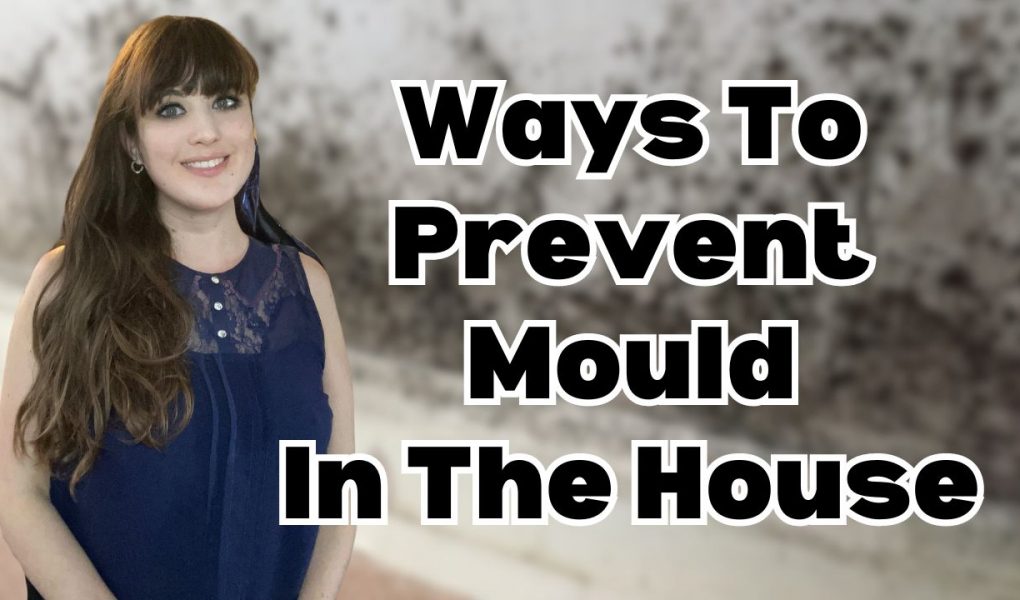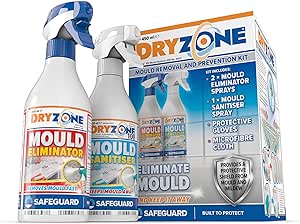As an Amazon Associate I earn from qualifying purchases.
On the JJ Barnes Blog, as online searches for ‘how to clean mould’ have rocketed this Spring, I check out top tips for ways to prevent mould in the house, and what to do if you find it.
Spring has sprung! The birds are singing, the flowers are blooming…and apparently, the mould is multiplying? If you’ve noticed a recent surge of unwelcome fuzzy patches in your home, you’re not alone.
Spring is a worrying time for homeowners, renters and landlords, as the rise in temperature can cause mould to grow and spread in homes. Indeed, online searches for “how to clean mould” have skyrocketed by 233% in April, according to data from Google Trends, leaving many homeowners scrambling for solutions.
To help tackle the problem, I’ll delve into the world of mould prevention thanks to help from thermal imaging experts at Tester, who sent over ways to identify and prevent the spread of mould, damp and mildew.
Why Is House Mould Dangerous?
Mould may start out as an unsightly splotch on your bathroom ceiling, but it can pose a significant health risk if left unchecked. Here’s why:
- Respiratory Issues: Mould spores are microscopic and easily inhaled. These spores can irritate the lungs, causing symptoms like coughing, wheezing, and difficulty breathing. People with allergies or asthma are particularly susceptible, and mould exposure can trigger attacks.
- Allergic Reactions: Mould can trigger allergic reactions in some people, causing symptoms like sneezing, runny nose, itchy eyes, and skin irritation.
- Toxins: Certain types of mould produce mycotoxins, toxic substances that can cause a range of health problems. These toxins can irritate the skin, eyes, and respiratory system, and in severe cases, even lead to neurological problems.
While not everyone will experience severe health effects from mould exposure, it’s important to take action to protect yourself and your family. Early detection and removal are key to preventing mould from becoming a health hazard.
Causes Of House Mould
Mould thrives in damp environments. Think of it like a party – the more moisture in the air, the bigger the celebration for mould spores. Here are some common sources of excess moisture that can fuel mould growth:
- Leaks: Leaky pipes, roofs, or windows are a one-way ticket to mould city. Any persistent leaks create a damp haven for mould spores to germinate and flourish.
- Poor Ventilation: Homes that lack proper ventilation trap moisture inside. This can be due to blocked vents, infrequent opening of windows, or activities that generate moisture, like cooking and showering, without proper exhaust.
- Condensation: Warm, humid air colliding with cool surfaces creates condensation, a breeding ground for mould. This is especially common in areas like bathrooms and kitchens.
- Organic Materials: Mould feeds on organic materials, such as wood, drywall, and even dust. Having damp carpets, furniture, or cluttered areas can provide a food source for mould spores.
- Temperature: Mould growth is favored by warm temperatures. While some types can tolerate colder environments, most thrive in the warmth often found in our homes.
How To Prevent Damp
According to a study by Utilita Energy, 20% of households regularly experience excessive condensation. These conditions can lead to damp in the home, which can be identified by damaged wallpaper and discoloured plasterboard. Wet patches along walls may also be the ideal breeding ground for mould, so it’s best to act quickly.
Dwellers can use thermal imaging cameras to prevent dampness within properties. By detecting heat—otherwise known as infrared energy and thermal energy—thermal imaging cameras highlight areas with excess moisture. They may find water behind walls and above rooflines, to name a couple of examples.
To reduce condensation and prevent it from forming, dwellers can take a few simple steps to remove excess moisture from their homes. This includes ventilating bathrooms after showering and kitchens after cooking, wiping windows to remove any condensation, heating the property and avoiding drying clothes inside. Dehumidifiers also work wonders to lower moisture levels inside a property.
Moisture Control is the Foundation:
- Tackle Leaks Promptly: Don’t let leaky pipes, faucets, or roofs linger. Address any leaks as soon as possible to prevent them from creating a haven for mould growth.
- Boost Ventilation: Proper ventilation is crucial for preventing moisture build-up. Here’s a two-pronged approach:
- Open windows regularly: Especially after cooking, showering, or doing laundry. Aim for at least 10-15 minutes of ventilation per room each day.
- Consider extractor fans: Install extractor fans in bathrooms and kitchens to remove excess moisture directly. Ensure they vent outside the house, not just into the ceiling cavity.
- Dehumidify When Needed: In areas prone to dampness, a dehumidifier can be a lifesaver. It helps remove excess moisture from the air, making it less hospitable for mould growth. However, using a dehumidifier alone won’t address the root cause of dampness.
Smart Habits for a Damp-Free Home:
- Mind Your Laundry: Don’t let damp clothes fester in the dryer or washing machine. Dry them promptly and ensure proper ventilation in laundry areas.
- Beware of Condensation: Condensation on windows and walls is a sign of excess moisture. Here’s how to tackle it:
- Wipe down condensation regularly.
- Consider double-glazed windows: They offer better insulation, reducing condensation on the inner pane.
- Increase air circulation around windows with trickle vents or by opening windows slightly when taking a hot shower.
- Furniture Placement: Avoid placing furniture too close to walls, especially exterior ones. This allows for better air circulation and prevents moisture build-up behind furniture.
Maintaining a Healthy Home Environment:
- Regularly Air Out Your Home: Open windows and doors whenever possible to allow fresh air to circulate and replace damp air. Even on cooler days, short bursts of ventilation can be beneficial.
- Don’t Block Vents: Ensure air vents are clear and functioning properly. Don’t cover them with furniture or block their airflow.
- Address Underlying Issues: If you suspect a more serious damp problem, like rising damp or structural issues, don’t hesitate to seek professional help from a qualified damp surveyor or contractor. They can identify the source of the dampness and recommend solutions like installing a damp-proof course or improving drainage.
How To Prevent Mildew
If left untreated, damp homes may also start to grow mildew. Mildew, defined as a form of fungus, can be identified by its grey, white or light brown appearance. It can quickly ruin fabrics and leave properties with a distinct, foul odour.
Just like mould, mildew can harm dwellers by causing allergic reactions and respiratory issues. It can be removed from properties with professional cleaning products or a mixture of bleach and water. It may also be worth mixing vinegar with warm water and wiping the area. Although, whether it’s black mould or red mildew, remember to take safety precautions and contact a professional if unsure.
Additionally, mildew can damage house plants by growing on the leaves, buds, petals, and shoots. This weakens the plants and may cause them to turn yellow or brown, as well as possibly drying them out completely. To prevent mildew from killing plants, dwellers can spray the infestation with neem oil—a naturally occurring pesticide—or a combination of water, baking soda and liquid, non-detergent soap. Mildew spores can also be killed with a simple one-part mouthwash and three-parts water mixture.
How To Remove Mould
When warm, moist air contacts a cold surface, mould spores can develop within 24 hours, becoming visible and spreading throughout the home in the next 18-21 days. Easily identifiable due to its fuzzy black appearance, mould can also present as green and red, and has an intense musty smell. While unpleasant, Utilita Energy’s study found that 24% of adults have found mould in their home at some point.
There are multiple health risks associated with mould. When living on a property with an infestation, dwellers may experience cold-like symptoms, such as coughing, sneezing, wheezing and nasal congestion. Mould spores can also exacerbate asthma and allergies, so acting quickly when noticing spores in a property is essential.
When wearing gloves, goggles and a mask, dwellers can remove the spores themselves by wiping the surface with professional mould removal liquid—or bleach diluted with water—before drying it with a cloth. If spores have touched any furnishings, clothes or cloths, they should be thrown away or professionally dry cleaned.
However, it is vital to ensure that the mould is a non-toxic strain caused by condensation rather than sewage or contaminated water before acting. Dwellers should also avoid mixing bleach with ammonia, acids or other cleaners, as this can release harmful, toxic fumes.
Choosing The Right Mould Remover
- Surface Type: Consider the surface you’re treating. Some removers are suitable for various surfaces (like tiles and grout), while others are better for specific materials (like fabric).
- Mold Severity: For light mold growth, a commercial mold remover might suffice. For extensive or stubborn mold, consider a professional cleaning service.
- Safety: Always prioritize safety. If you have concerns about harsh chemicals or have respiratory issues, opt for a less toxic option or consult a professional.
Safety Tips
Safety First: Always wear gloves, eye protection, and a mask when using any mold remover.
Ventilation: Ensure proper ventilation when using any mold removal product.
Address the Cause: Remember, mold removal is only one step. It’s crucial to identify and address the underlying moisture problem to prevent future growth.
Sources
- Google Trends
- Utilita Energy
Methodology
This campaign examined UK-based online searches for ‘cleaning mould’, ‘what is mould’ and ‘mould on walls’ between April 3rd to the 10th 2024 on Google Trends.
Amazon and the Amazon logo are trademarks of Amazon.com, Inc, or its affiliates.






